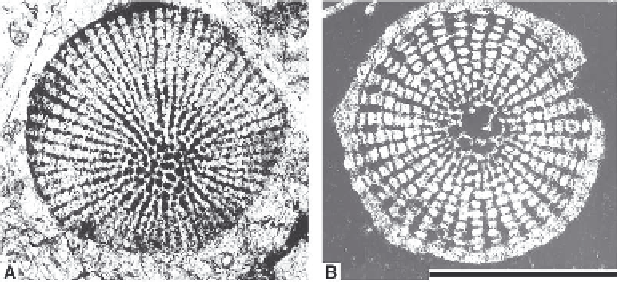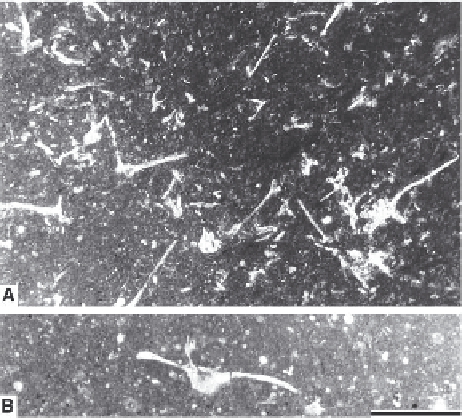Geology Reference
In-Depth Information
float as long as the skeletal elements are filled with
organic tissue, was discussed by Ruhrmann (1971b).
Submarine fissures and neptunian dikes formed after
drowning of carbonate platforms can act as traps for
crinoid accumulations (Pl. 24/4, Pl. 139/6). Deposition
on seamounts is believed to have been controlled by
submarine currents (Jenkyns 1971).
The
differentiation of depositional environments of
crinoid limestones
requires answers to the following
questions:
•
Which elements of the crinoids have been preferen-
tially deposited (stems, columnals, plates, brachials
etc.)?
•
How well preserved are the elements (e.g. totally or
partly disarticulated, long crinoid stems or even
crinoid crowns)?
•
Are the crinoid elements broken, worn, abraded or
conspicuously altered (Pl. 95/3, 4)?
Fig. 10.56.
Saccocoma
limestone.
A
: This microfacies is char-
acterized by numerous antler-shaped calcitic structures float-
ing in a fine-grained matrix of pelagic micrite. Late Jurassic
(Kimmeridgian): Central Apennines, Italy.
B
: Cross section
of a
Saccocoma
arm element (brachialia). Late Jurassic:
Thurburbo majus, northern Tunisia. Scale is 500
m.
•
Do crinoid stems show signs of current orientation?
•
Are the elements bored or encrusted (Pl. 52/6, 7)?
•
How abundant are the crinoids with regard to the
rock volume?
•
Are the crinoid elements grain- or mud-supported?
and occur with
Saccocoma
Agassiz in great abundance
in Tethyan Jurassic open-marine limestones as well as
in epicontinental shelf carbonates (Fig. 10.56).
•
What about the sorting of crinoids and other grains?
•
Do crinoids contribute to specific depositional fab-
rics (e.g. gradation, lamination)?
•
What other skeletal and non-skeletal grains are as-
sociated with the crinoids (Pl. 95/1)?
Triassic roveocrinoids
(Pl. 96/1) occur in wide dis-
tribution in the Tethys within a specific time interval
comprising the Late Ladinian and the Early Carnian
(Kristan-Tollmann 1970).
Other important questions in the context of the ge-
netic interpretation of crinoid limestones refer to field
criteria (geometry, sedimentary structures), lateral and
vertical extension of the crinoid limestones, and inter-
bedding with other facies types.
The first record of
Saccocoma
is from late Middle
Jurassic, mass occurrences are abundant within the time
interval Kimmeridgian to middle Tithonian. The plank-
tonic life-style of
Saccocoma
was questioned by Manni
et al. (1997) who favored a possible benthic mode of
life. Anatomical and taphonomical criteria as well as
the distributional pattern argue against this interpreta-
tion (Keupp and Matyszkiewicz 1997).
Planktonic crinoids
Elements of non-stalked planktonic crinoids are im-
portant, sometimes rock-forming constituents of pelagic
carbonates. These crinoids are known from the Trias-
sic of the Alpine-Mediterranean region (roveocrinoids)
Fig. 10.57.
Echinoid spines with
stereom-filled center.
The pattern cor-
responds to the
Cidaris
type distin-
guished by Hesse (1900).
A
: The reticu-
late structure of the central zone is sur-
rounded by a zone of densely arranged
radial septa. The septa are connected by
rings of interseptal bars.
B
: The gen-
eral structural pattern resembles that of
A but the spine is covered by a distinct
peripheral border. A and B: Early Per-
mian: Forni Avoltri, Carnia, Italy. Scale
is 500
m.


